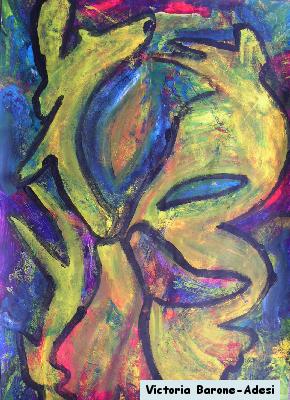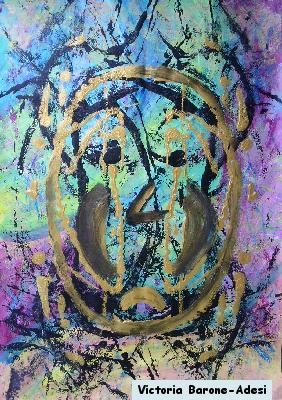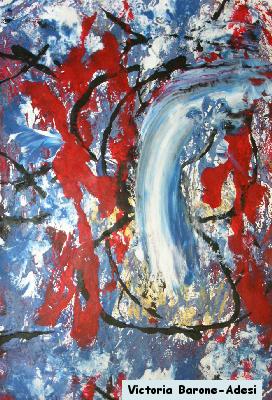|
| Reviews of Victoria Barone-Adesi's paintings |

Victoria Barone-Adesi, a nineteen-year-old student, started painting a year ago: to express herself and realize her potential, but also to diffuse joy (in one of her writings she affirms: "I want my paintings to bring happiness."). In reality, those who contemplate her works feel a special joy, and also surprise for the spontaneous wisdom of a beginner.
Using acrylic colors, Victoria paints animals, landscapes, dream-like visions, everything blended and connected with a halo, a habitat, a border; color is the true protagonist of her paintings, whether it presents itself in pure tones (see "Purple Hills", "Magic Forest"), or appears in a sort of mixture of reciprocal copenetrations (see "Rain Stream", "Red Sky", "Red Eyes", "Blue Eye"). You notice a swan losing its whiteness in a series of dark colorations (is it about to die singing?); a happy dolphin dancing over a mountain of joyful images (an underwater mountain?); a red flow of lava, perhaps coming out of a vulcano; a girl who jumps almost until she disintegrates; a wild horse meditating on its imminent capture; a fire in the shape of a cradle in which it would be nice to lie down. And in front of works like "Cardinal red" and "Red", how not to think about the red coals of Scipione (to which even the name "Cardinal" refers)?
In fact, due to the familiarity of the painter with all the best artists of the last millennium, it would not be too bold to affirm that a little of each of them is present in her paintings, from Tiziano to the Impressionists to the Roman School. Their signatures are not there but, after Victoria's inventions have been read carefully, the painters of the past, remote and recent, will not be able to negate their presence, even if it is submitted to the paintbrush of a talented adolescent.
Luca L. Lamperini, Roma, February 2006.
The realm of art is starkly separate from the realm of nature, and the determination of artistic forms depends only on interior pulses of the subject. The figurative theme is subordinated to the development of harmonies of color and linear rhythms, perhaps inspired by music.
In the works of Barone-Adesi, the category of "meaningful" is wider and closer to reality than the category of "rational". In other words signs, corresponding to given meanings, i.e, representative languages with forms logically relating to objects are turned-off signs, because their communication is mediated by objects of common experience (nature). Esthetic communication wants to be inter-subjective, going from person to person without the intermediation of nature or object. In his essay "On the spiritual in art" Kandinsky explains that each form has its own specific content: not an objective or knowledge-based content (such as the one by which space is known and represented by geometric forms), but a content of strength, a capacity to act as a psychological stimulus. A triangle originates different spiritual motions from a circle: the former gives a feeling of something tending to rise, the latter of something concluded. Whatever the origin of this so-called semantic content forms, an artist uses them as the keys of a piano, touching them to "make the human soul vibrate". Obviously, colors are forms, like the triangle and the circle: yellow has a different semantic meaning from blue. The semantic meaning of a form changes according to the color that is associated with it: "stinging colors resonate better of their quality when given in acute shapes (as an example yellow in a triangle); deep colors are reinforced by round shapes ( as an example blue in a circle)".
Not only is a form meaningful because it has, but because it acquires a meaning. But it does not become significant outside the conscience that perceives it, in the same way that a communication is not occurring if it is not received. The sign is not pre-existing as a letter in the alphabet - it is something that is born from the deep pulse of the artist and therefore is not separable from the gesture drawing it.
Victoria is evidently not leaning on any visual or linguistic experience, her works are aggregate movements of signs without any structural support or visible order. In the same painting there are signs from different seeds - it is impossible to combine them in a coherent discourse, morphologically and syntaxically: points, commas, zig-zags, curves, straight lines, stains, clouds of color. From a reality in which it is immersed the author has not received images of defined objects, but rather objects still or in motion, acute or round, threadlike or expansive. A stimulus from which one is relieved by reacting or expressing, that is translating internal motion into visible signs. What then is the meaning of a picture? Art is conscience, meant as rational order of phenomena. It is the category of active meanings, infinitely wider than the category of passive meanings which is nature. The painting is not a model but a stimulus, not a transmission of forms but of forces: the existence of the artist connecting directly to the existence of others.
Altogether the work of Victoria is a special diary of her deep inner life. Her aim is not to represent but to visualize: visualization follows the laws of perception. It represents something that has a form in the outside world or in the perception of the artist. It visualizes something that, before visualization, has no phenomenological existence. Last year she started painting and she wants her paintings to bring happiness.
Caterina Ostone, August 2006

Indian's Life
Blessed land
from God in nature
that respects
every peace and looks after
life and death togethere
but without fear
or resignation
but pure strength

The shaman's crying
A hard hearted and minded people
like all others
that doesn't listen to
the voice of God
and of nature
and finds only death
in its destiny
when her spirit
tries to bring
life everywhere

Christus' naissance
Flesh pink
of motherly love
until blood
in an infinite hug
of light and peace
for this world ended
in a breath of ashes

Canadian's life
All life in a few signs:
waterfall, flag, earth
sky, flowers, paradise
without war
in a soul that looks
at its country
from inocent eyes of a child

Angel's wings in the lava
Powerful nature
that can't stop
the grace of God
that
always manifests
even in death
Emilia Daria Clerici, 12 2008
|
Copyright 2009 Victoria Barone-Adesi |





